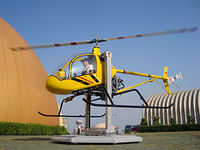Augusto Cicaré Scientist
Augusto Ulderico Cicaré (born May 25, 1937 in Polvaredas, Argentina) is an Argentine inventor, engineer and aviation designer. Cicaré constructed his first engine at the age of 11, while by age 15 he was constructing motorcycle engines.In 1958, despite having never seen an actual helicopter before, and knowing little of helicopter design, Cicaré's first successful helicopter design, the CH-1, flew for the first time, with its designer as the test pilot, teaching himself how to fly in the process. The CH-1 was the first helicopter to have been designed and built in South America. By 1972, Cicaré was developing his third helicopter.In the late 1960s, Cicaré designed a V-4 engine for use in DKW automobiles, the engine being extensively tested by racing driver Juan Manuel Fangio. A version of the engine for use in motorsports competition was also developed, but the closure of DKW resulted in the termination of the project.Cicaré continues to be active in aviation design, recent work including the Cicaré CH-10 and CH-11 ultralight helicopters, and the development of the Cicaré SVH-3 flight simulator, which was declared Argentina's national invention of the year in 1998.
Search
Scientist
| awards | Juan Manuel Fangio Prize |
|---|
